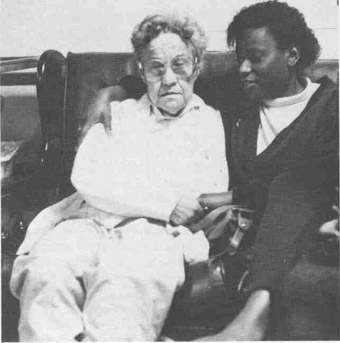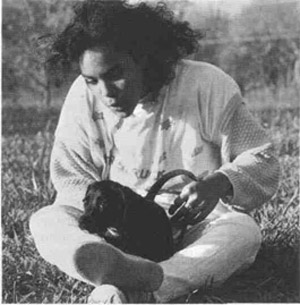|
At-risk youth find meaning in
community service projects
by
Anita Magafas, Ph.D.

|
n Oct. 24,1990, Congress passed the National and
Community Service Act of 1990 (HR 4330). In
doing so, the government has acknowledged the
need for active contributions of young people to
address challenges in areas such as conservation,
education, emergency responses, child care, drug use, care for
elderly and people with disabilities. These are areas in which
young people can improve the quality of life in America by
providing services not readily available in the labor force. Beyond
serving vital social functions, youth volunteers gain experience
and skills and become more employable, productive and self-respecting as citizens.
|
|
With these values and goals in mind, Chaddock School in
Quincy, Ill., a child care agency for at-risk youth, incorporated
community service into their therapeutic treatment program.
Service learning, another term used to emphasize the learning
component of community service programs, involved youths
from the agency in a number of service projects with other
community agencies. This program was initialed in 1983 and has
continued to prove beneficial to the youth of Chaddock, the
community and the many agencies that have been involved over
the seven-year period of successful operations.
At Chaddock School, involvement began with a mock disaster drill sponsored by the Quincy Emergency Service and Disaster
Agency for Adams County. The purpose of the drill was to
provide the emergency network in the community with a practice
experience to test their efficiency and communications with the
local hospitals. Chaddock, with interest in community service
projects for youth, was chosen as the site, and students, along with
staff, acted as victims while emergency crews labored to provide
the care needed for injuries which had been assigned to each
victim.
The drill was a good first-time experience in service learning.
Not only was it enjoyable to be involved with a real experience
that benefitted the welfare of the community, but everyone learned about ambulances as well as first aid procedures and
hospital emergency room operations that would occur in case of
a disaster. The community and agency interaction was both
positive and synergetic.
Community service projects have continued to grow in the
|

Most children who have been abused or neglected do
not know how to establish relationships based on care
and respect. Visiting local nursing homes helps students
discover the joy of developing these relationships
and of knowing that they have brightened someone
else's day.
|
Illinois Parks and Recreation 19 January/February 1991
|
treatment program at Chaddock. Several on-going projects occur
on a weekly basis. One cottage of youth at Chaddock work as
teachers' aids in a weekly physical education class for Head Start
children. The children from Head Start have used Chaddock's
swimming pool and have been carefully watched and cared for
during the swim session by their Chaddock teachers' aids.
The Illinois Veteran's Home in Quincy and Chaddock youth
have developed positive relationships as a result of a service learning project in which Chaddock students wrote invitations to
elderly veterans who have been identified by the Veteran's Home
personnel as potential guests of the students to view the annual
Kiwanis film series. A foster grandparent program with some of
the younger adolescents and the veterans has resulted from this
initial project and continues with such activities as fishing trips
and friendly visits between those involved in the two agencies.
|
Perhaps one of the greatest benefits of community service is
that while it involves risks, all individuals can experience success.
For youth-at-risk who have experienced failure in school or with
family or peers, accomplishing a successful service to someone
else in need brings many intangible rewards that can help formulate a redirection in learning and lifestyle.
As an intergeneralional activity, older people served by youth
have a greater chance to remain independent, can be involved with
young people as an antidote to loneliness, and get real needs met
such as the delivering of groceries or the building of wheelchair
ramps. The youth experience real service to others, work closely
with adult role models, gain employment skills, and experience
relevant learning. By this participation, symptomatic behavior is
overcome and the potential to stay in school is increased when
service learning projects are incorporated into the school or
treatment program. Benefits to the community are provided by
the civic mindedness of those agencies and volunteers involved in
community service while a mechanism is created to link young
people to their hometowns. This is especially beneficial in rural
areas where the flight of youth is a serious problem.
|
|
Community service may be
implemented as a therapeutic tool in
several ways. At Chaddock, the aim
has been to involve youth with preschool and senior citizen age groups.
The connection is made by an initial
phone call by Chaddock personnel to
determine the needs of each of the
local community agencies. With
Special Olympics, we found a need
for basketball coaches. With Head
Start, we found a need for teachers'
aids in physical education, reading
and art. With a local day care center,
we found the need for special events
such as seasonal parties for the children. With the Illinois Veteran's
Home, we found the need for intergenerational companionship. With
the local Retired Senior Volunteer
Program (RSVP), we found the need
to mutually serve shut-in elderly. With
the Quincy Recycle Committee, we
found the need to sort glass, paper
and aluminum cans once a month.
|

Chaddock students offer comfort and companionship
to abandoned animals through weekly visits
to the local animal shelter. As the students interact
with the animals, their faces reflect the positive
and powerful impact that being needed can have.
|
What are the potential problems in using community service
as a therapeutic intervention? Organizationally, good communication among agencies is critical. The agencies involved must
understand one another's goals and needs. Dedicated leadership
is needed to set up the projects
and train youth volunteers for
service in the community agencies. The seeming paradox is
that the value of the service
rendered is less than the value
of the service experienced by
the participant. It is not actually
a paradox; the young person will
benefit from the experience only
to the extent that the service
activity is useful and is perceived by the youth to be useful.
Community service and
service learning projects have
continued to involve the youth
at Chaddock since 1983.
|
|
Two
years after the inception of the
community service program,
Chaddock youth received a
"Volunteer Of The Year" Award
from the local community for
the service project entitled,
"Carry-Out-Caravan" which
provides groceries to shut-in
elderly. The project was co-sponsored by the RSVP program of Adams County.
With the local animal shelter, we found the need to walk and bathe
the canine and feline orphans of the city.
The proceeding examples indicate the large scope and variety
of projects in community service. How a therapeutic recreation
treatment team incorporates community service is dependent
upon the agency's mission and structure. The basic element in any
project selected must be based on real need. Projects cannot be
contrived, artificial, or make-work, but must be a genuine response to meeting human needs.
|
This type of recognition has brought
personal satisfaction to the youth volunteers and enhanced their
own selfworth. The therapeutic value of community service has
a seven year record of success at Chaddock School and provides
potential for many agencies serving troubled youth in the state.
About the Author
Anita Magafas was formerly the supervisor of Therapeutic
Recreation at Chaddock School. She has a Ph.D. from the
University of Iowa and is currently assistant professor in the
Department of Recreation, Park and Tourism Administration at
Western Illinois University, Macomb, III. Photos by Shellie Palm
|
Illinois Parks and Recreation 20 January/February 1991
|

